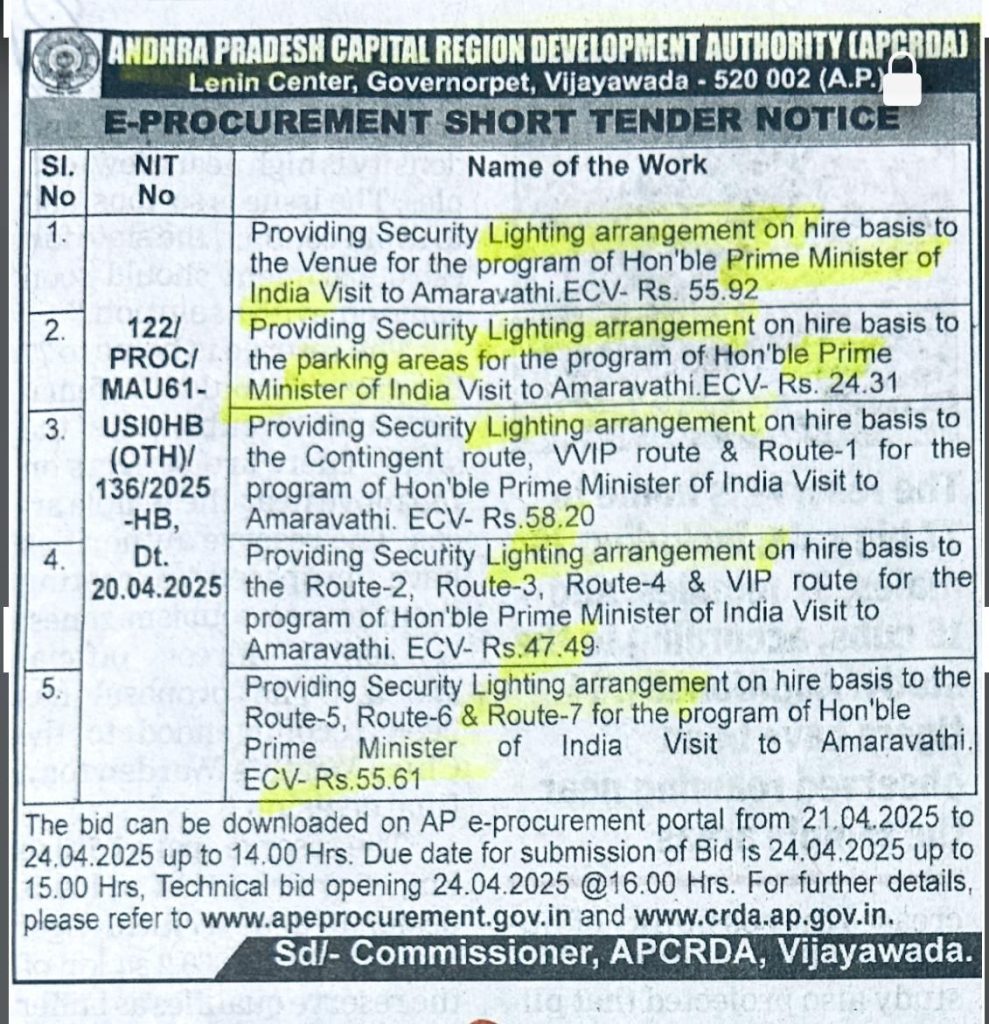How Amaravati Has Gone From Grand Blueprint to Ghost Town – and Back
Hyderabad: A decade after its grand inauguration, Prime Minister Narendra Modi ceremonially relaunched the Amaravati Capital Project on May 2, marking a fresh push to revive what was once envisioned as a futuristic state capital.
In 2015, Amaravati was announced as Andhra Pradesh’s new capital with much fanfare, promising world-class infrastructure and economic growth. However, political shifts, funding delays and legal disputes left the project in limbo.
Now, with a renewed commitment of Rs 65,000 crore, the Union and state governments aim to breathe life back into the ambitious venture.
Yet, the high-profile relaunch has also reignited debates over why India’s mega-projects often face repeated delays and, in this case, a costly reboot. Critics point to bureaucratic hurdles, shifting political priorities and a lack of long-term planning as key challenges.
The historical context
When Andhra Pradesh was bifurcated in 2014, leaving Hyderabad as the temporary joint capital of the newly formed Telangana and the residual state, the latter needed a new administrative centre. Amaravati, a town with historical and spiritual significance located on the banks of the Krishna River, was chosen for this task.
On October 22, 2015, Modi laid the foundation stone for Amaravati amidst much fanfare. The event was grand and attended by dignitaries from India and abroad, and symbolised a new beginning.
The initial vision was inspired by modern cities like Singapore and Putrajaya, aiming for a sustainable, green and technologically advanced urban centre.
Not the only delayed project Modi has launched or inaugurated
Amaravati is not the first delayed project that Modi has launched. Similar delays have marred other major projects.
The Eastern Peripheral Expressway in Delhi NCR, whose foundation stone was first laid by Modi in 2015, was inaugurated only in 2018.
The Surat Metro, work for which Modi launched in 2021, has had its completion date now pushed to 2027.
Also read: Promises or Platitudes? Questions on Union Govt's Contributions to Amaravati After Modi's Visit
Meanwhile, the Sudarshan Setu bridge in Gujarat, construction for which began in 2017, was only inaugurated in 2024.
Even the Yashobhoomi Convention Centre in Delhi, after a foundation stone-laying ceremony in 2018, was only partially completed in 2023.
These delays raise questions about the government's ability to deliver on its promises. With the Amaravati Capital City Project poised for another restart in 2025, the public is left to wonder whether the government's infrastructure ambitions are truly about building a better India, or just laying foundation stones for the sake of optics.
From grand blueprint to ghost city – and back
The ambitious project, envisioned by N. Chandrababu Naidu in 2014, became a casualty of Andhra Pradesh's intense political rivalry.
However, Y.S. Jagan Mohan Reddy's ascension in 2019 triggered a dramatic reversal of the project’s stated aims when his government halted construction and proposed a controversial three-capital plan.
Alleging financial irregularities, Reddy's move was widely seen as a political manoeuvre to dismantle Naidu's legacy and consolidate his own support base.
This led to widespread protests, legal battles and years of uncertainty. Farmers who had surrendered land for the project felt betrayed and the state faced prolonged instability.
Ultimately, with Naidu's return to power in 2024, Amaravati's revival commenced, marked by renewed Union government and World Bank funding.
Controversies over Amaravati
During the first phase of Amaravati’s development, several allegations of insider trading surfaced. It was alleged that politicians including then-chief minister Naidu as well as his family and close associates, influential businessmen and even ministers from the then-ruling Telugu Desam Party (TDP) were tipped off about the location of the new capital prior to the official announcement.
Using this privileged information, they reportedly purchased large tracts of agricultural land at low prices, anticipating a massive rise in value once Amaravati's location was officially declared.
Naidu’s son, Nara Lokesh, then TDP general secretary, also faced accusations of securing prime land in key areas prior to the announcement.
Other ministers allegedly implicated included Y. Ramakrishnudu, the then-finance and planning minister, who was allegedly linked to strategic land investments near decision-making hubs, and Kinjarapu Atchannaidu, the then-labour and employment minister, accused of leveraging political influence for favourable deals.
The scandal triggered widespread criticism, multiple probes and cast a shadow over Amaravati’s development. While no conclusive legal action followed, the controversy significantly undermined public trust and the subsequent government halted the project.
Also read | Amaravati's Growing Pains: Soaring Land Prices, Falling Farm Fortunes
World Bank withdrawal: a major setback
In a significant blow to the Amaravati project, the World Bank withdrew its proposed $300 million funding in 2019.
The bank had initially agreed to support infrastructure and sustainable development efforts for Amaravati, but allegations related to irregularities in the land acquisition processes, concerns raised by farmers' groups and complaints filed with the World Bank’s internal accountability mechanisms led to an independent investigation.
The World Bank had reportedly pointed to the need for a more detailed review of environmental and other concerns. It decided to pull out of the project on the grounds that the Union government had withdrawn its request for financing.
This development not only caused a funding crunch but also dented investor confidence, as other global institutions, including the Asian Infrastructure Investment Bank, followed suit by withdrawing their support.
After the NDA coalition government came to head the Union government in 2024, the World Bank’s board of executive directors approved an $800 million funding initiative to support Amaravati’s development.
Expenditure of the 2015 foundation ceremony
The 2015 foundation event became a subject of political debate. The Andhra Pradesh government officially declared that it spent about Rs 9 crore on the ceremony, which covered logistics, hospitality, security and transportation.
However, the opposition party, the YSR Congress (YSRCP), had alleged that the real expenditure was close to Rs 400 crore, accusing the administration of wasteful extravagance.
However, this time around, the Andhra Pradesh government allocated Rs 2.41 crore for lighting arrangements and Rs 88.5 lakh for preparing a 3D model of Amaravati to display in the prime minister’s event.

Photo: Balakrishna M.

Photo: Balakrishna M.
Revival sees infusion of Rs 65,000 crore into project
The newly elected Andhra Pradesh government has kickstarted the project’s ambitious revival, approving a massive Rs 65,000 crore investment package. Naidu's administration has prioritised completing critical infrastructure by 2026, including roads, utilities, government complexes and urban amenities.
While the move has reignited hopes of economic transformation – with projections of 1.5 million new jobs – it still faces challenges, including farmer protests over new land acquisitions and environmental concerns about large-scale construction near the Krishna River basin.
The government has allocated Rs 11,467 crore for immediate works and is seeking international partnerships to fast-track development.
Addressing a public meeting, the TDP chief declared that his government would prioritise infrastructure development, attract global investments and create employment opportunities in the new capital region. “We will develop Amaravati as a modern, sustainable and vibrant capital that all of Andhra Pradesh can be proud of,” Naidu said.
The chief minister said his administration would work transparently and engage with all stakeholders, including farmers who had originally contributed land for the capital project under the previous TDP regime.
Destruction of agricultural land
The land acquisition for the Amaravati airport and other infrastructural projects could lead to the further destruction of fertile agricultural land. According to reports, more than 10,000 acres of land in the region, primarily used for growing crops like rice, groundnuts and sugarcane, will be converted into urban spaces.
This loss will have a long-term impact on food security and the local agricultural economy. The fertile lands surrounding Amaravati, known for their high agricultural productivity, support three or four cropping cycles annually, making the region a key contributor to Andhra Pradesh’s food supply.
Farmers here cultivate rice (2 million metric tons per year), groundnut (over 500,000 metric tons) and sugarcane (300,000 metric tons), alongside vegetables and fruits worth an estimated Rs 1,000 crore annually.
However, the state’s push to develop Amaravati as the capital could lead to a significant decline in crop output, jeopardising local livelihoods and regional food security.
Airport expansion sparks land debate
The state has proposed acquiring up to 40,000 additional acres for expansion projects for Amaravati that are to include a greenfield international airport near the city, a move aimed at transforming the region into a logistics hub. This fresh land acquisition follows the earlier pooling of 33,000 acres from farmers through the state's innovative land pooling scheme.
While the government promises “transparent compensation”, the plan has reignited concerns about agricultural land conversion, with activists demanding stricter environmental and social impact assessments.
Opposition slams relaunch as ‘political gimmick’
The YSRCP has clarified that it is not opposed to the Amaravati project but to alleged insider trading, illegal land grabs and the misuse of assigned lands during the previous TDP regime.
K. Venkat Reddy, a state joint secretary in the party, told The Wire: “The government pooled 35,000 acres of fertile land and 20,000 acres of government land now they want another 45,000 acres. Is destroying 1 lakh acres of fertile land justified?”
He questioned the Union government's stance, recalling its opposition to the University of Hyderabad’s 400-acre allocation while now supporting Amaravati's massive land acquisition. Highlighting financial concerns, he said, “Under the TDP, Rs 5,200 crore was borrowed at high interest. Now, Rs 31,000 crore in loans are finalised, with proposals for Rs 69,000 crore more this will cripple the state.”
This article has been translated from the Telugu original published in The Wire Telugu.
This article went live on May fifteenth, two thousand twenty five, at eight minutes past one at night.The Wire is now on WhatsApp. Follow our channel for sharp analysis and opinions on the latest developments.




